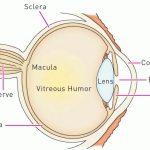What is the Vestibular Apparatus?
The vestibular apparatus involves the ear structures responsible for perceiving your body’s orientation relative to the ground (determining if you are upside down, standing up straight, falling etc.), this information is then passed to the eyes and limbs and tell us how to position one’s body to stay in balance.
Basically, the vestibular system consists of the structures of the middle ear, the nerves that carry their messages to the brain/central nervous system, and the brain/central nervous system itself.
What’s in the Middle Ear?
There are two sets of receptors involved: one to detect rotational movement like tumbling or turning and another to detect falling and let us know which direction is up and which is down. These receptors are both located in the middle ear.

Rotation is detected using the three semicircular canals as shown above. These canals contain fluid called endolymph, which moves as the head rotates and send messages to nerves that communicate with the cerebellum (part of the brain that coordinates walking, running and any other locomotion).
Up and down orientation stems from small weighted bodies called otoliths, which are located within structures of the middle ear. These structures communicate up and down positioning.
If there is trouble in the vestibular apparatus, then you may not properly perceive your orientation. To put it more simply, you won’t know which way is up, whether or not you are standing up straight or slanted, and you’ll feel dizzy.
The Signs of Vestibular Disease
The following are signs of vestibular disease:
- Ataxia (lack of coordination without weakness or involuntary spasms – in other words, a drunken, stumbling gait and staggering).
- Motion sickness.
- Nystagmus (rapid back and forth or rotational eye movements – The movements will be slower in one direction. This is the side where the neurologic problem is likely to be.
- Trouble with other nerves controlling the head and face.

A vascular accident of mini-stroke can result is a head tilt
Vestibular signs are commonly (and usually incorrectly) referred to as a stroke. While a vascular accident is a possible cause of vestibular signs, it is less likely in pets, although possible if other issues that cause high blood pressure, for example are present.
Causes of Vestibular Disease
In order to determine prognosis and choose treatment, one needs to figure out what has happened to the vestibular system. The first step is to determine whether the lesion is central – in the brain – or peripheral (in the inner ear).
Idiopathic Disease (Unknown Origin)
Idiopathic vestibular disease is the most common form of vestibular disease in dogs and cats. For unknown reasons, cats are most commonly affected in the northeast U.S. in the late summer and early fall.
Canine idiopathic vestibular disease (also called old dog vestibular disease) and its feline counterpart, feline idiopathic vestibular disease, begin acutely and resolve acutely. Usually improvement is evident in 72 hours and the animal is normal in 7 to 14 days, although occasionally a head tilt will persist. When a case of vestibular disease begins, it may be a good idea to wait a few days to see if improvement occurs before doing diagnostics beyond a routine blood/urine database. These two conditions are idiopathic, meaning we do not know why they occur. We do know that they represent problems in the periphery (nerves of the middle ear rather than in the brain.)
Treatment of idiopathic vestibular disease generally involves control of nausea (motions sickness) while the condition runs its relatively short course.
Brain, the Central Lesion
There will be some hints in the clinical presentation that the patient in question has a brain lesion causing the vestibular signs. For example, if other cranial nerves are involved and they are on the side opposite from the head tilt, then the lesion is likely to be in the cerebellum (central). If the nystagmus is vertical (the eyes are moving up and down rather than back and forth) or only exists when the animal is placed in certain positions, then the lesion is more likely to be central.
If the vestibular signs have a central origin, there could be a tumor, vascular accident, infection (especially tick borne diseases) or other lesion in the brain. Imaging of the brain will be important in determining the nature of the lesion and what treatment makes the most sense. This means a CT scan or MRI to image the brain; most likely a referral will be needed for this type of procedure. General anesthesia is required for CT and MRI.
Middle Ear Infection
Middle ear infection is a likely possibility for vestibular disease especially if the patient has a history of ear infections. Concurrent facial nerve paralysis, creating a ‘dropped’ look to one side of the face, often go together with middle ear infection.
When an otoscope is used to visualize the external ear of an animal with vestibular disease and debris is seen, this would be a good hint that there is infection in the middle ear as well. However, just because debris is not seen in the external ear does not mean that a middle ear infection is unlikely. Imaging of the middle ear bones may be in order.
The most accessible way to evaluate the middle ear is with a set of radiographs called a bulla series (so named because it focuses on an ear bone called the tympanic bulla). If the bulla appears abnormal, the ear may require surgical drainage. The problem is that radiography is often not sensitive enough to pick up damage in the middle ear and a normal set of films does not rule out disease. In these cases, imaging such as a CT scan or MRI is better, although rather expensive. These imaging techniques, however, allow imaging of the brain tissue itself (which radiology does not), thus allowing brain abnormalities to be evaluated as well.
If the pet has a middle ear infection, a routine cleaning of the external ear can lead to a flare up of vestibular symptoms. This is often unavoidable in long-standing ear infections as there is no simple way to know if an external ear infection extends into the middle ear.
Treating a known middle ear infection can be difficult. Culture of the middle ear may be necessary and oral antibiotics are needed for 6 to 8 weeks to clear the infection from the tiny bones of the middle ear. Surgery may be needed to open the tympanic bullae and flush them out.


